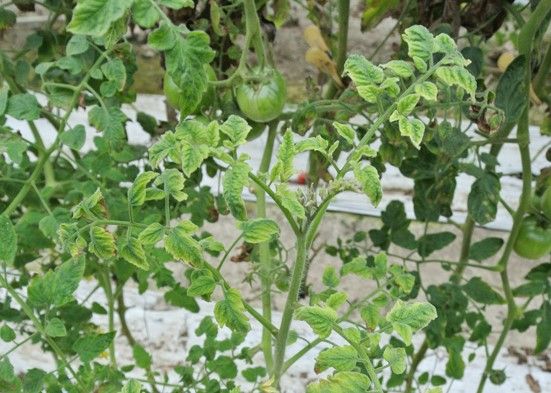
Press release -
First report of a begomovirus species infecting tomato plants in Okinawa -- Virus invasion from overseas poses a threat to tomato production across Japan -- Kindai University
A research group from Kindai University Graduate School of Agriculture (Nara City, Nara Prefecture), consisting of a Master student Marina Taniguchi, associate professor Sota Koeda, and others, are researching the begomovirus, which has become a threat to tomato production all over the world. They have isolated a species of the begomovirus in Okinawa prefecture previously unreported in Japan. They also state that this begomovirus is more virulent compared to those already spread in Japan and could increase the damage even with the resistant cultivars.
A research article of this study was published online in Journal of General Plant Pathology, the international journal of phytopathology, at 10:00 AM on Wednesday, November 2nd, 2022.

A resistant tomato cultivar showing the disease symptoms
Typical symptoms of the begomovirus were found in resistant tomato cultivars in Okinawa, Japan
1. Key Points
- A species of begomovirus yet to be reported in Japan has been identified in Okinawa-grown tomatoes
- The newly identified begomovirus is prone to cause disease in virus-resistant tomatoes
- The study alerts for the invasion of foreign viruses to the tomato producing areas across Japan
2. Background
There are currently 445 species of begomovirus, affecting many agricultural crops such as tomatoes, capsicums, cucumbers, melons, squashes, zucchinis, okras, and beans. They have become a worldwide threat to agriculture, ruining most of the harvest from infected plants.
Producer have battled this begomoviral caused disease with insecticides, since the virus is transmitted through an insect vector called whitefly (Bemisia tabaci). However, due to overuse of insecticides, whiteflies resistant to insecticides are becoming predominant all over the world. Tomato yellow leaf curl virus (TYLCV), a species of begomovirus which causes tomato yellow leaf curl disease, invaded from Israel to Japan, Europe, and North America in the 1990s, causing significant damage to tomato production.
As a result of worldwide research, the TYLCV resistance genes have been identified and virus-resistant cultivars are being bred widely. However, there has been fear of a different type of begomovirus invading Japan from overseas and increase the damage.
3. Overview
From studies conducted at tomato producing areas in Okinawa, the research group found that TYLCV-resistant tomato cultivars had shown tomato yellow leaf curl disease, caused by the begomovirus. From analysis of viral genome sequences, they discovered that the tomatoes was infected by lisianthus enation leaf curl virus (LELCV), the first case to be reported in Japan. Inoculation of LELCV to virus-resistant tomato cultivars clarified that it is more virulent compared to TYLCV, which is already prevalent in Japan. Furthermore, coinfection of LELCV and TYLCV causes severe symptoms in resistant tomato cultivars.
These results indicate the importance of staying alert to invasion of foreign viruses, as well as revealing their characteristics promptly upon invasion. Researchers plan to conduct studies aiming to breed tomato cultivars with strong resistance to LELCV and other virulent species of begomovirus.
4. About Publication
Journal name:
Journal of General Plant Pathology
(Impact Factor: 1.217@2021-2022)
Research paper title:
Lisianthus enation leaf curl virus, a begomovirus new to Japan, is more virulent than the prevalent tomato yellow leaf curl virus in Ty-gene-mediated resistant tomato cultivars
Authors:
Marina Taniguchi1, Ken-Taro Sekine2, Sota Koeda1*
*Corresponding author
Affiliation:
1 Kindai University Graduate School of Agriculture,
2 University of the Ryukyus Faculty of Agriculture
URL:
https://link.springer.com/article/10.1007/s10327-022-01101-5

